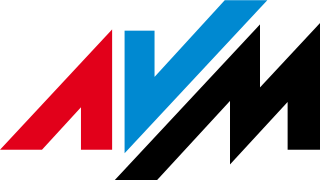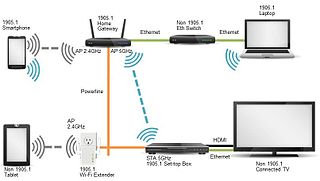The HomePNA Alliance is an incorporated non-profit industry association of companies that develops and standardizes technology for home networking over the existing coaxial cables and telephone wiring within homes, so new wires do not need to be installed.
Zigbee is an IEEE 802.15.4-based specification for a suite of high-level communication protocols used to create personal area networks with small, low-power digital radios, such as for home automation, medical device data collection, and other low-power low-bandwidth needs, designed for small scale projects which need wireless connection. Hence, Zigbee is a low-power, low data rate, and close proximity wireless ad hoc network.
Power-line communication carries data on a conductor that is also used simultaneously for AC electric power transmission or electric power distribution to consumers.
The HomePlug Powerline Alliance is a trade association of electronics manufacturers, service providers, and retailers that establishes standards for, and tests members' devices for compliance to, the various power line communication technologies known as HomePlug.
HomePlug is the family name for various power line communications specifications under the HomePlug designation, each with unique capabilities and compatibility with other HomePlug specifications.
The EnOcean technology is an energy harvesting wireless technology used primarily in building automation systems, but also in other application fields such as industry, transportation, logistics or smart homes solutions. The energy harvesting wireless modules are manufactured and marketed by the company EnOcean, headquartered in Oberhaching near Munich. The modules combine micro energy converters with ultra low power electronics and wireless communications and enable batteryless, wireless sensors, switches, and controls.
The IEEE Std 1901-2010 is a standard for high speed communication devices via electric power lines, often called broadband over power lines (BPL). The standard uses transmission frequencies below 100 MHz. This standard is usable by all classes of BPL devices, including BPL devices used for the connection to Internet access services as well as BPL devices used within buildings for local area networks, smart energy applications, transportation platforms (vehicle), and other data distribution applications.

A home network or home area network (HAN) is a type of computer network that facilitates communication among devices within the close vicinity of a home. Devices capable of participating in this network, for example, smart devices such as network printers and handheld mobile computers, often gain enhanced emergent capabilities through their ability to interact. These additional capabilities can be used to increase the quality of life inside the home in a variety of ways, such as automation of repetitive tasks, increased personal productivity, enhanced home security, and easier access to entertainment.
Qualcomm Atheros is a developer of semiconductor chips for network communications, particularly wireless chipsets. Founded under the name T-Span Systems in 1998 by experts in signal processing and VLSI design from Stanford University, the University of California, Berkeley and private industry. The company was renamed Atheros Communications in 2000 and it completed an initial public offering in February 2004 trading on NASDAQ under the symbol ATHR.

AVM is a consumer electronics company founded in 1986 in Berlin, Germany. The company produces communications, networking devices such as DSL, ISDN, Wireless and VoIP products. It had sales of €580 million in 2020 with 840 employees. It is well known for its popular FRITZ!Box series.

A smart meter is an electronic device that records information such as consumption of electric energy, voltage levels, current, and power factor. Smart meters communicate the information to the consumer for greater clarity of consumption behavior, and electricity suppliers for system monitoring and customer billing. Smart meters typically record energy near real-time, and report regularly, short intervals throughout the day. Smart meters enable two-way communication between the meter and the central system. Such an advanced metering infrastructure (AMI) differs from automatic meter reading (AMR) in that it enables two-way communication between the meter and the supplier. Communications from the meter to the network may be wireless, or via fixed wired connections such as power line carrier (PLC). Wireless communication options in common use include cellular communications, Wi-Fi, wireless ad hoc networks over Wi-Fi, wireless mesh networks, low power long-range wireless (LoRa), Wize ZigBee, and Wi-SUN.
Design of Systems on Silicon, officially Diseño de Sistemas en Silicio S.A., (DS2), was a supplier of integrated circuits and software for power line communications. The company was founded in 1998, and went out of business in 2010 after trying to expand into other home network technologies.

The Universal Powerline Association (UPA) was a trade association that covered power line communication (PLC) markets and applications. The UPA promoted and certified power line communication technology from 2004 to 2010.
G.hn is a specification for home networking with data rates up to 2 Gbit/s and operation over four types of legacy wires: telephone wiring, coaxial cables, power lines and plastic optical fiber. A single G.hn semiconductor device is able to network over any of the supported home wire types. Some benefits of a multi-wire standard are lower equipment development costs and lower deployment costs for service providers.
The Internet Protocol for Smart Objects (IPSO) Alliance was an international technical standards organization promoting the Internet Protocol (IP) for what it calls "smart object" communications. The IPSO Alliance was a non-profit organization founded in 2008 with members from technology, communications and energy companies. The Alliance advocated for IP networked devices in energy, consumer, healthcare, and industrial uses. On 27 March 2018, the IPSO Alliance merged with the Open Mobile Alliance (OMA) to form OMA SpecWorks.
LiquidHD technology was an architecture and a set of protocols for networking consumer electronics devices. It was designed to let consumers link their HDTVs, home theater components, PCs, gaming consoles, and mobile devices into local entertainment networks, where they could view high-definition digital content from any networked source device on any compliant display. Silicon Image promoted LiquidHD in 2009 and sponsored a website for it that year.
Networking cables are networking hardware used to connect one network device to other network devices or to connect two or more computers to share devices such as printers or scanners. Different types of network cables, such as coaxial cable, optical fiber cable, and twisted pair cables, are used depending on the network's topology, protocol, and size. The devices can be separated by a few meters or nearly unlimited distances.
Gigle Networks was a provider of high performance system-on-a-chip semiconductor devices and intelligent switching technology for home network, IPTV, consumer electronics and smart grid applications. The company was based in Barcelona, Spain, Edinburgh, UK, and Redwood City, California.
The OpenHAN standards for home networks was promoted by groups such as openAMI and UtilityAMI. Both efforts aim to standardize powerline networking interoperation from a utility point of view and ensure reliable communications co-extant with AC power outlets. Both utilities and vendors of home control have promoted such standards aggressively. The openHAN label usually denotes standards favored by the utilities, not other service providers. It should be distinguished from the openADR standards that were promoted to ensure open access to customer electricity use data by all service providers.

IEEE 1905.1 is an IEEE standard which defines a network enabler for home networking supporting both wireless and wireline technologies: IEEE 802.11, IEEE 1901 powerline networking, IEEE 802.3 Ethernet and Multimedia over Coax (MoCA).






